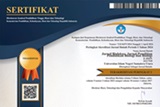STUDI META-ANALISIS PENGARUH VIDEO PEMBELAJARAN TERHADAP HASIL BELAJAR PESERTA DIDIK
Abstract
Full Text:
PDFReferences
Adesote, S.A., and Fatoki, O.R. (2013). The role of ICT in the teaching and learning of history in the 21st century. Academic Journals, 8 (21), 2155-2159.
Altunnisik, Remzi. (2013). The Role of Lecturer Related Factors in Students’ Perceptions and Satisfaction in Distance Education. Science Direct, 3075-3083.
Anindyawati, Linaksita. (2015). Pemanfaatan Media Video Pembelajaran Untuk Meningkatkan Hasil Belajar Ips Pada Siswa Kelas IV SDN Babatan I/456 Surabaya. Skripsi tidak dipubilkasikan. Universitas Negeri Surabaya, Surabaya.
Berutu, M.H.A. & Tambunan, M.I.H. (2018). Pengaruh Minat dan Kebiasaan Belajar Terhadap Hasil Belajar Biologi Siswa SMA Se-Kota Stabat. Jurnal Biolokus, 1 (2), 109-115.
Bravo, E., Amante, A., Simo, P., & Enache M. (2011). Video as a new teaching tool to increase student motivation. Global Engineering Education Conference IEEE, 40 (3), 638-642.
De Jong, T. (2010). Cognitive load theory, educational research, and instructional design: Some food for thought. Instructional Science, 38 (2), 105-134.
Erniwati, Rosliana Eso, & Sitti Rahmia. (2014). Penggunaan Media Praktikum Berbasis Video dalam Pembelajaran IPA-Fisika untuk Meningkatkan Hasil Belajar Siswa pada Materi Pokok Suhu dan perubahan. Jurnal Sains dan pendidikan Sains, 10(3), 269-273.
Fish, K., Mun, J., & A’Jontue, R. A. (2016). Do visual aids really matter? A comparison of student evaluations before and after embedding visuals into video lectures. Journal of Educators Online, 13 (1), 194–217.
Gardner, H. (2000). Can technology exploit our many ways of knowing?” In D.T. Gordon (Ed.), The digital classroom: How technology is changing the way we teach and learn. Cambridge, MA: Harvard College.
Greenberg, A., & Zanetis, J. (2012). The impact of broadcast and streaming video in education. San Jose, CA: Cisco.
Giannakos, M. N., Chorianopoulos, K., & Chrisochoides, N. (2015). Making sense of video analytics: Lessons learned from clickstream interactions, attitudes, and learning outcome in a video-assisted course. International Review of Research in Open and Distance Learning, 16 (1), 260–283.
Jewitt, Carey. (2012). An Intruduction tu Using Video for Research. London: Intitude of Education National Center for Reseach Methods Working Paper.
Joni. (2015). Hubungan Media Pembelajaran Dan Motivasi Belajar Terhadap Prestasi Belajar Bidang Studi Sejarah Siswa Sma Negeri 3 Lumajang. Jurnal Penelitian dan Pendidikan IPS (JPPI), 9(2), 1198-1209.
Kirkorian, Heathe L, Ellen A. Wartella dan Daniel R. Anderson. (2008). Media and Young Children’s Learning. Published by Princeton University 18 (1) 39 – 61.
Kustandi, Cecep & Sutjipto, Bambang. (2013). Media Pembelajaran Manual dan Digital Edisi Kedua. Bogor: Ghalia Indonesia.
Ljubojevic, M., Vaskovic, V., Stankovic, S., & Vaskovic, J. (2014). Using supplementary video in multimedia instruction as a teaching tool to increase efficiency of learning and quality of experience. The International Review Of Research In Open and Distance Learning (IRRODL), 15(3), 275–291.
Marques, J.C., Quintela, J., Restivo, M.T., & Trigo, V. (2012). The use of video clips in engineering education. In Proceedings of Interactive Collaborative Learning (ICL),15th International Conference, 1 – 4.
Mayer, R. E. (2009). Multimedia learning (2nd edition). New York: Cambridge University Press.
Megawati. (2017). Pengembangan Media Pembelajaran Video Berbasis Inkuiri untuk Meningkatkan Hasil Belajar Siswa pada Materi Keseimbangan Ekosistem. Prosiding Seminar Nasional Tahunan FIS UNIMED 127 – 130. (2010). Opportunities and Challenges Of Electronic Learning. Economics and Organization, 7(2), 191 – 199.
OECD. (2016). Chapter 3 of the Publication “PISA 2015 Assesment of Framework – Matematich, Reading, Science and Problem Solving Knowledge and Skills. Retrieved from http://www.oecd.org/dataoecd/.pdf. (14 November 2017).
Putri, Nadya. (2012). Efektifitas Penggunaan Media Video untuk Meningkatkan Pengenalan Alat Musik Daerah pada Pembelajaran IPS Bagi Anak Tunagrahita Ringan di SDLB 20 Kota Solok. Case Study Reseach, 15 (6), 1-26.
Robet. (2013). Pembuatan Materi Belajar dengan Pendekatan Video-Based Learning. Jurnal TIMES, 2 (2), 39-41.
Riyana, Cheppy. 2007. Pedoman Pengembangan Media Video. Jakarta: P3AI UPI.
Saeed, S., & Zyngier, D. (2012). How Motivation Influences Student Engagement: A Qualitative Case Study. Journal of Education and Learning, 1 (2), 252-267.
Sun, H., & Gao, Y. (2016). Impact of an active educational video game on children’s motivation, science knowledge, and physical activity. Journal of Sport and Health Science, 5(2), 239–245.
Uno, Hamzah B., dan Lamatenggo, Nina. (2011). Teknologi Komunikasi dan Informasi Pembelajaran. Jakarta: Bumi Aksara.
Thompson, Christine Marme; S. Alex Ruthmannn; Eeva Anttila;
William J. Doan. (2014). Model New Media/Video Programs in Arts Educat. Valle, A., Cabanach, R. , Nunez, J., Gonzalez-Pienda, J.,
Rodriguez, S., & Pineiro, I. (2003). Cognitive, motivational, and volitional dimensions of learning. Research in Higher Education,44,557-580.
Wang, W. F., Chen, C. M., & Wu, C. H. (2016). Effects of Different Video Lecture Types on Sustained Attention, Emotion, Cognitive Load, and Learning Performance. Proceedings - 2015 IIAI 4th International Congress on Advanced Applied Informatics, IIAI-AAI 2015, 80, 385–390.
Woolfitt, Zac. (2015). The Effective Use of Video in Higher Education. Inholland University of Applied Sciences.
DOI: http://dx.doi.org/10.30821/biolokus.v2i1.442
Refbacks
- There are currently no refbacks.
Copyright (c) 2019 JURNAL BIOLOKUS
indexed by :












